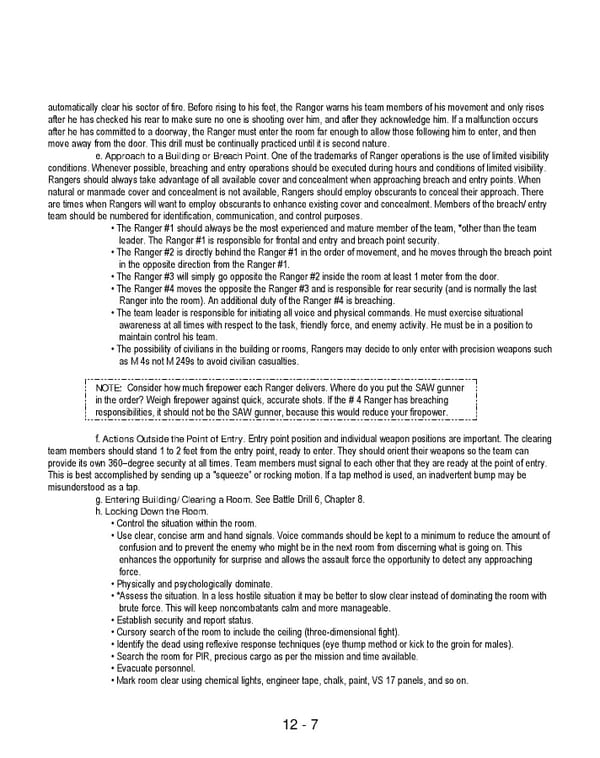12 - 7 automatically clear his sector of fire. Before rising to his feet, the Ranger warns his team members of his movement and only rises after he has checked his rear to make sure no one is shooting over him, and after they acknowledge him. If a malfunction occurs after he has committed to a doorway, the Ranger must enter the room far enough to allow those following him to enter, and then move away from the door. This drill must be continually practiced until it is second nature. e. Approach to a Building or Breach Point. One of the trademarks of Ranger operations is the use of limited visibility conditions. Whenever possible, breaching and entry operations should be executed during hours and conditions of limited visibility. Rangers should always take advantage of all available cover and concealment when approaching breach and entry points. When natural or manmade cover and concealment is not available, Rangers should employ obscurants to conceal their approach. There are times when Rangers will want to employ obscurants to enhance existing cover and concealment. Members of the breach/ entry team should be numbered for identification, communication, and control purposes. • The Ranger #1 should always be the most experienced and mature member of the team, *other than the team leader. The Ranger #1 is responsible for frontal and entry and breach point security. • The Ranger #2 is directly behind the Ranger #1 in the order of movement, and he moves through the breach point in the opposite direction from the Ranger #1. • The Ranger #3 will simply go opposite the Ranger #2 inside the room at least 1 meter from the door. • The Ranger #4 moves the opposite the Ranger #3 and is responsible for rear security (and is normally the last Ranger into the room). An additional duty of the Ranger #4 is breaching. • The team leader is responsible for initiating all voice and physical commands. He must exercise situational awareness at all times with respect to the task, friendly force, and enemy activity. He must be in a position to maintain control his team. • The possibility of civilians in the building or rooms, Rangers may decide to only enter with precision weapons such as M 4s not M 249s to avoid civilian casualties. NOTE: Consider how much firepower each Ranger delivers. Where do you put the SAW gunner in the order? Weigh firepower against quick, accurate shots. If the # 4 Ranger has breaching responsibilities, it should not be the SAW gunner, because this would reduce your firepower. f. Actions Outside the Point of Entry. Entry point position and individual weapon positions are important. The clearing team members should stand 1 to 2 feet from the entry point, ready to enter. They should orient their weapons so the team can provide its own 360–degree security at all times. Team members must signal to each other that they are ready at the point of entry. This is best accomplished by sending up a "squeeze” or rocking motion. If a tap method is used, an inadvertent bump may be misunderstood as a tap. g. Entering Building/ Clearing a Room. See Battle Drill 6, Chapter 8. h. Locking Down the Room. • Control the situation within the room. • Use clear, concise arm and hand signals. Voice commands should be kept to a minimum to reduce the amount of confusion and to prevent the enemy who might be in the next room from discerning what is going on. This enhances the opportunity for surprise and allows the assault force the opportunity to detect any approaching force. • Physically and psychologically dominate. • *Assess the situation. In a less hostile situation it may be better to slow clear instead of dominating the room with brute force. This will keep noncombatants calm and more manageable. • Establish security and report status. • Cursory search of the room to include the ceiling (three-dimensional fight). • Identify the dead using reflexive response techniques (eye thump method or kick to the groin for males). • Search the room for PIR, precious cargo as per the mission and time available. • Evacuate personnel. • Mark room clear using chemical lights, engineer tape, chalk, paint, VS 17 panels, and so on.
 Ranger Handbook Page 230 Page 232
Ranger Handbook Page 230 Page 232